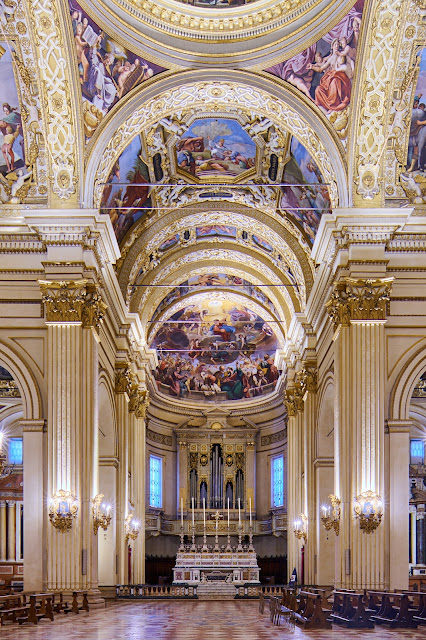I was asked in a photo discussion to describe how I put together a series of shots of the Ghiara in Reggio Emilia. I thought it might be interesting to make a short Blog post about how I went about getting the final images.
These shots were made in dim difficult lighting conditions with a huge dynamic light range. I made a series of horizontal and vertical shots with a Nikon Z7 + Laowa 15mm Zero D shift, on a monopod with feet. My tripod with a geared head would have been a better support, but tripods are often not allowed in these venues in Italy. The monopod often gets around this problem.
 |
| The shooting rig |
First, let us look how the image was exposed. Thee shots were made in short succession with a metered midway exposure and one shot overexposed by two stops, and one underexposed by two stops.
 |
| The final shot |
 |
| Metered exposure |
 |
| Metered exposure +2 stops |
 |
| Metered exposure -2 stops |
The + 2 stops exposure takes care of retaining detail in the shadow areas. The more important -2 stops shot takes care of brightly lit windows and the lighting.
The shots were made at F8 with shots at approximately 2 seconds, 8seconds. and 30seconds.
The shots were combined in Capture one and the default image was obtained. Using the masking tools, certain areas were lightened or darkened and other parameters like colour balance, saturation contrast and such were tweaked.
 |
| Capture One default HDR output. |
I had shot this place before with my Nikon 24mm PC lens, but I thought this venue deserved something more dramatic.
 |
| A shot made with the 24mm PC |
If we look at this hand held test shot made with the 24mm PC, the representation of the geometry looks quite credible, apart from the cupola base curves at the very top of the frame. The lens was at full shift vertically.
 |
| Shot made with the 15mm shift. |
Incidentally, cropping the 15mm PC image down to the same image area of the 24mm PC shows that the perspective effects are now the same as the 24mm image above.
Vertical shots with shift lenses are more prone to giving results that look unnatural, with the stretching evident at the top (or bottom) of the frame with vertical shift. Horizontal shots, even with the 15mm at full vertical shift, still mostly look natural, unless some object is jutting out into the picture, I think, it is because we see the "stretching" on three sides.
 |
| The horizonal version of the first picture. |
But the perspective becomes dramatic and theatrical, and unnatural, with the 15mm, when I shot across the nave at 45°. I explored the perspective effects of different wide angle lenses, in a previous post.
 |
| 15mm lens |




No comments:
Post a Comment